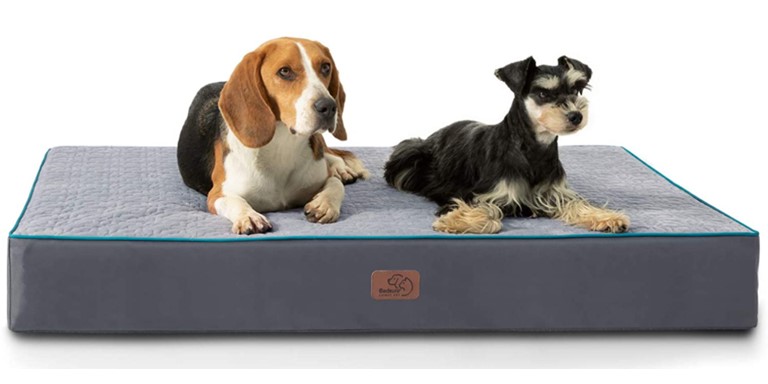Best Dog Bed With Hip Dysplasia
Orthopedic Beds Are The Best!

Hip Dysplasia is a term that most dog owners are terrified about. Usually associated with large dog breeds, however, small dogs can suffer from this condition. Best dog bed with hip dysplasia will recommend what type of dog beds should be used with dogs suffering from this disease.
This article will help potential new pet owners of this disease and what they can do to help slow it down and suggestions on treatment. Hip dysplasia has some symptoms that you can notice if your dog suffers from this condition. Some of these symptoms are mentioned below.
Introduction
Dog owners love their pets and when they suffer a health condition, they will go out of their way to make it better. So, your pet has hip dysplasia and you may be wondering what this disease is all about. The topics below will introduce you to the disease it and some of the symptoms you can look for when it’s in the early stages. It you should observe any of them, you can contact your vet to begin the proper treatment.
We also have a topic on the treatments vets can prescribe for your pet. Some are non-surgical and some do require surgery. Your vet will go over all of these treatments if your pet should have hip dysplasia.
Video – Hip Dysplasia
This is a short video on hip dysplasia. Vets discuss available options if your pet is diagnosed with this disease and what medications are also available. Take a look!
What Is Hip Dysplasia
Most dog owners think that hip dysplasia basically is a condition in large dog breeds like Great Danes, Saint Bernards, Labrador Retrievers, and German Shepherds. It’s the abnormal development and growth of a dog’s hip joint. However, all dog breeds can suffer from this condition.
Hip dysplasia is a common skeletal condition associated with large dogs and can occur in small dogs. The hip joint functions as a ball and socket. If your pet suffers from hip dysplasia, the ball and socket do not fit or develop properly. They will rub and grind instead of sliding smoothly. As a result, over time deterioration will develop and an eventual loss of function of the joint.
What Is The Cause?
First and foremost, it begins with genetics. Hip dysplasia is hereditary and most common in large dogs. Here are some factors that can cause this:
- Excessive Growth Rate
- Types of Exercise
- Obesity
- Improper Nutrition
The above factors play a vital role and can magnify the genetic predisposition if they exist with your dog. The next question is, what can I do? Read on.
Some puppies have special nutritional needs and must have food that is especially formulated for large breed puppies. The foods help prevent excessive growth that can lead to skeletal disorders like hip dysplasia, elbow dysplasia, and other joint conditions. By slowing down this growth process allows their joints to develop normally and prevent problems later.
Improper nutrition can influence a dog’s likelihood of developing hip dysplasia. Also, too much exercise or too little. Obesity places lots of stress on their joints, which can worsen the condition or even cause hip dysplasia. Talk with your vet on the proper amount of exercise your dog breed should have each day. This will help keep him in good physical condition.
Symptoms of Hip Dysplasia
Now that we told you what hip dysplasia is and some of the causes, now it’s important to know the symptoms. When you see any of the following symptoms, you can take the appropriate action.
Some dogs will show signs of hip dysplasia when they are young as four months old. Other dogs develop it in conjunction with osteoarthritis. The American Kennel Club says: “Osteoarthritis, also referred to as Degenerative Joint Disease (DJD), is a progressively worsening inflammation of the joint caused by the deterioration of cartilage.”
In both of these situations, owners can look for some symptoms they are familiar with. Please note, these symptoms may vary depending upon the severity of the disease, level of inflammation, and degree of looseness of the joint.
These symptoms are:
- Decreased Activity
- Decreased Range of Motion
- Difficulty or Reluctance Rising, Jumping, or Climbing Stairs
- Difficulty in Getting Up
- Clicking Sound from Hips When Moving or Getting Up
- Lameness In The Hind End
- Unable to Exercise For Long Periods
- Swaying (Bunny Hopping)
- Shifting of Weight to The Front Legs
- Grating In The Joint During Movement
- Loss of Thigh Muscle Mass
- Notice Enlargement of The Shoulder Muscles as They Compensate for The Hind End
- Pain
- Stiffness or Limping
If you should notice any of these symptoms, you can talk with your vet so he can confirm if your pet suffers from hip dysplasia.
Diagnosing Hip Dysplasia in Dogs
After observing your dog to determine if he has displayed any of the hip dysplasia symptoms, you take your dog to the vet for his regular physical exam. At that time, you inform your vet that you have seen your dog display some of the symptoms.
At this point, your veterinarian will perform an exam. This exam is enough for the vet to suspect if your dog has hip dysplasia. Then, the vet may ask you about your dog’s health history, symptoms, and possible incidents or injuries that may have contributed to his current symptoms. The vet may also ask if your dog is experiencing any discomfort.
Finally, for conclusive evidence, he will do an X-ray. This will help him to determine the degree and severity of the hip dysplasia. He will then offer a course of treatment for your dog.
Treating Hip Dysplasia
After your dog has been diagnosed with hip dysplasia, there are some treatment options available for you to use. These range from lifestyle modifications to surgery. If your dog’s case is not severe, or not a candidate for surgery, your veterinarian may recommend some nonsurgical options.
He may suggest any of the following:
- Weight reduction to reduce the stress off the hips
- Exercise restriction, especially on hard surfaces
- Physical therapy
- Joint supplements
- Anti-inflammatory medications (nonsteroidal anti-inflammatory drugs, corticosteroids)
- Joint fluid modifiers
If your dog should be a good candidate for surgery, there are more options available to you. The most common surgeries veterinarians use in treating hip dysplasia in pets are:
- Double or triple pelvic osteotomy (DPO/TPO)
- Femoral head ostectomy (FHO)
- Total hip replacement (THR)
Each of these options are explained below. The descriptions below are from the American Kennel Club.
DPO/TPO
DPO/TPO surgery is usually performed in young dogs less than 10 months old. In this surgery, the function of the ball and socket joint is improved by selectively cutting the pelvic bone and rotating the segments.
FHO
FHO surgery can be performed on young and mature dogs. The surgery involves cutting off the femoral head, or “ball,” of the hip joint. This results in the body creating a “false” joint that reduces the discomfort associated with hip dysplasia. While FHO does not recreate normal hip function, it can be a successful pain management strategy.
THR
The most effective surgical treatment for hip dysplasia in dogs is a total hip replacement. The surgeon replaces the entire joint with metal and plastic implants. This returns hip function to a more normal range and eliminating most of the discomfort associated with hip dysplasia.
As you can see, there are options for you to choose if your dog should be diagnosed with hip dysplasia.
Preventing Hip Dysplasia in Dogs
There is no way that all cases of hip dysplasia can be prevented. Taking all of the actions in preventing hip dysplasia may not be enough to reduce your dog’s risk of developing this disease. However, feeding your puppy an appropriate diet will give them a head start on healthy bone and joint development. Also, help prevent the excessive growth which can lead to the disease.
Providing your dog the appropriate levels of exercise and healthy diet will prevent obesity. Obesity is a major factor to hip dysplasia. Obesity is a cause of other health problems in dogs. So, don’t feet your dog any table scraps and fatty foods. Always use food or treats specifically made for dogs.
When you are considering on being an owner of a new dog, do some research first on the breed you are interested in. Take note if the breeder does health screenings, such as radiographs for hip dysplasia and more.
The Best Dog Bed To Use For Hip Dysplasia
The best dog beds to use if your dog has been diagnosed with hip dysplasia is an orthopedic dog bed. What you are looking for are orthopedic dog beds made with memory foam. True memory foam helps support the joints and hips and evenly distributes his weight on the bed to reduce this pressure. Also, memory foam is excellent for dogs that suffer from arthritis.
It does not matter if your dog is a large or small breed or somewhere in-between, most dogs will encounter some form of muscle or joint pain as they age. An orthopedic dog bed is the best in reducing the pain they suffer.
Not all orthopedic memory foam dog beds are the same. Look for is a good quality memory foam bed that is made in the USA. Memory foam that is used from countries outside the United States, may use foam made with toxins that are not healthy for dogs and humans.
A true orthopedic dog bed will have a layer of therapeutic memory foam from 2-4 inches, and a layer of support foam at least 2 inches or more underneath.
You should look for the CertiPUR-US trade mark (see image). This certifies the foam is certified for quality, durability, and product safety. It was also made without using any harsh chemicals that can be harmful to dogs and humans. CertiPUR–US-certified foams meet standards for content, emissions and durability, and are analyzed by independent, accredited laboratories.
The CertiPUR–US foam certification program, administered by a nonprofit organization, was established in 2008 to combat substandard foams imported from other countries. Countries outside the United States can participate in the program as long as they meet the rigorous certification standards. If they are meet, their products can use the seal.
Conclusion
We presented you with a lot of material to digest. If you are considering on being a pet owner, you should know before hand what you may be up against when it comes to the health of your dog.
Dogs can live long lives even with hip dysplasia, if treatment is used. Always talk with your veterinarian if you think your dog may be affected or showing symptoms of hip dysplasia.
The best dog bed for dogs with hip dysplasia are orthopedic memory foam beds with the CertiPUR-US certification.
We have provided a link for you to shop for orthopedic dog beds made in the USA.
Go back to the Dog Luxury Beds home page.
